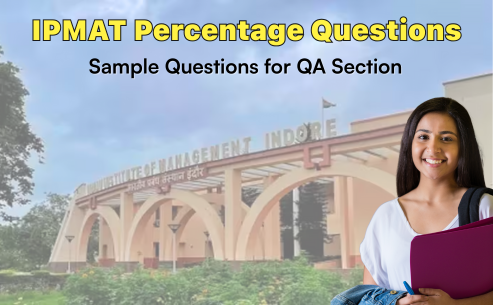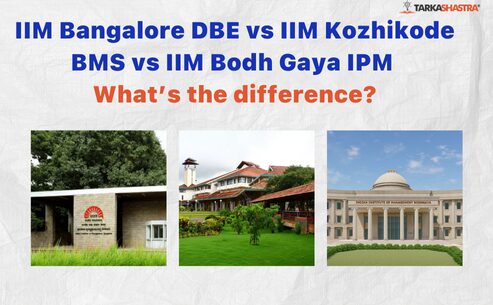The Integrated Program in Management Aptitude Test (IPMAT) is a gateway to the prestigious 5-year IPM programs offered by IIM Indore and IIM Rohtak, of the two main sections of IPMAT—Quantitative Ability (QA) and Verbal Ability (VA)—the QA section is often seen as a game-changer.
One of the most frequently tested and high-scoring topics in the QA section is Percentages. From direct calculations to advanced word problems and even Data Interpretation (DI), percentage-based logic forms the backbone of many IPMAT Quant questions.
But why do so many students stumble on this seemingly basic topic?
It’s usually because:
- They focus only on formulas and ignore conceptual understanding
- They don’t practice IPMAT-style percentage questions
- They lack a structured revision strategy
This blog will help you:
- Understand how percentages are tested in IPMAT QA
- Master all essential concepts with examples
- Solve handpicked sample questions (from beginner to advanced levels)
- Avoid common mistakes and time traps
This guide will give you a quantitative edge whether you’re just starting your preparation or revising this topic before the final exam.
Quick Fact:
In previous years, 4–6 questions in IPMAT Indore QA had direct or indirect percentage concepts—making it one of the most critical topics to master.
IPMAT QA Section Overview
The Quantitative Ability (QA) section in IPMAT tests a student’s numerical aptitude, logical thinking, and time management skills. It includes a mix of short-answer and MCQ-based questions that range from fundamental arithmetic to high-school-level math.
Before diving into percentage questions specifically, it’s essential to understand how the QA section is structured and where percentages fit in.
IPMAT Indore QA Section – Key Highlights
| Feature | Details |
| Total Questions | 45 |
| Types of Questions | Short Answer (SA) – 15 MCQs – 30 |
| Total Marks (QA Section) | 180 (4 marks per correct answer) |
| Negative Marking | Yes, -1 for MCQs No negative marking for SA |
| Time Allotted | 180 minutes |
Strategy Tip: Questions involving percentages may appear directly or as part of topics like Profit & Loss, Data Interpretation, and Compound Interest.
Common Topics in IPMAT QA Section
Here’s a breakdown of commonly tested topics in QA and their typical representation:
| Topic | Approx. No. of Questions | Relevance of Percentages |
| Percentages | 3–4 | Core Concept |
| Profit, Loss & Discount | 2–3 | Based on Percentages |
| Simple & Compound Interest | 1–2 | Direct Application |
| Ratio & Proportion | 2–3 | Linked via % Conversion |
| Number System | 2–3 | Basic Arithmetic |
| Time, Speed, Distance | 1–2 | Logical Reasoning |
| Data Interpretation | 3–5 | % Change, Comparisons |
| Algebra & Linear Equations | 2–4 | Variable-based % problems |
Why Focus on Percentages?
Mastering Percentages gives you a strong base for at least 6–8 questions, directly or indirectly. It also improves your ability to estimate and eliminate options quickly, which is crucial given the time constraints of the exam.
Importance of Percentages in IPMAT
You might think percentages are just basic school math. But in IPMAT, they are far more than that. The concept of percentage is deeply embedded in various QA topics, and a strong understanding of it can help you solve a wide range of questions with accuracy and speed.
Why Are Percentage Concepts So Important?
- Foundation for Multiple Topics
Topics like Profit & Loss, Simple & Compound Interest, and Discounts are entirely built on percentage logic. If you’re not strong in this area, you’ll struggle with at least 20–25% of the QA section.
- Frequently Used in Data Interpretation (DI)
In DI questions, especially those based on tables, pie charts, or caselets, calculations often revolve around percent increase/decrease, percentage contribution, or comparison using % change.
- Shortcut Opportunities
Percentage-based questions allow powerful shortcuts and mental math tricks (like % ↔ fraction conversions) that can save precious time.
- Real-Life Application Style
IPMAT has a trend of asking application-based questions. For instance:
- “The population increases by 20% in 2 years…”
- “A student scores 60% marks in one subject and 80% in another…”
These require you to understand the concept, not just apply formulas.
Where You’ll Encounter Percentage Logic
| Topic | How Percentage is Involved |
| Profit, Loss, & Discount | Calculated on Cost Price or Marked Price using % |
| Simple Interest | Interest = (P × R × T) / 100 → Direct use of % |
| Compound Interest | Successive % changes in principal over time |
| Population Growth/Depreciation | Modeled using % increase or decrease |
| DI (Data Interpretation) | % change, % share, average % – used extensively |
| Exam-style Word Problems | Real-life contexts requiring conceptual application |
Example:
If the price of a commodity increases by 25%, by what percentage must a consumer reduce consumption to keep the expenditure the same?
This is a classic IPMAT-level application question that combines percentage increase with inverse adjustment, a favorite theme of the exam.
Core Concepts You Must Know
Before you attempt percentage questions in IPMAT, it’s crucial to master the foundational concepts. These aren’t just formulas—they’re the mental tools that help you solve questions faster and more accurately.
Let’s break them down:
1. Percentage Basics
- Definition: A percentage is a fraction expressed with 100 as the denominator.
→ x% = (x/100)
- Usage in IPMAT: Many questions involve converting real-life values to percentages or vice versa to find totals, differences, or changes.
2. Percentage Change
- The formula for Increase/Decrease:
→ Percentage Change = [(New Value – Old Value)/Old Value] × 100
- IPMAT Tip: Focus on identifying the base value correctly. Errors in picking the base often lead to incorrect answers.
3. Successive Percentage Changes
- When two or more percentage changes are applied successively:
→ Net Change = a + b + (ab/100)
- (Where a and b are the individual percentage changes)
Example: If a value increases by 20% and then decreases by 10%,
→ Net % Change = 20 – 10 + (20×(-10)/100) = 10 – 2 = 8% increase
4. Percentage to Fraction Conversion (Must Memorize)
These conversions help with mental math and are often helpful in IPMAT for estimation:
| Percentage | Fraction |
| 1% | 1/100 |
| 5% | 1/20 |
| 10% | 1/10 |
| 12.5% | 1/8 |
| 20% | 1/5 |
| 25% | 1/4 |
| 33.33% | 1/3 |
| 50% | 1/2 |
| 66.66% | 2/3 |
| 75% | 3/4 |
| 80% | 4/5 |
| 90% | 9/10 |
5. Finding the Base Value
Many percentage problems in IPMAT twist the question by giving you the final value and asking you to find the original or base value.
Example:
If 40% of a number is 80, what is the number?
→ Let the number be x.
40% of x = 80 → (40/100)x = 80 → x = 200
6. Comparing Using Percentages
This is especially relevant in DI sets or choice-based MCQs.
Example:
If Candidate A scores 60% and Candidate B scores 75%, who did better if their total marks differed?
→ Always compare absolute values, not just the percentages, or normalize them based on the total.
Common Percentage Question Types in IPMAT
IPMAT doesn’t just test your ability to plug values into formulas. It challenges your understanding of context, logic, and speed—especially in topics like percentages, where questions may appear in direct or disguised forms.
Let’s explore the percentage-based questions you’ll most likely see in the IPMAT Quantitative Ability (QA) section.
a. Basic Percentage Calculations
What it tests: Direct application of formulas and conversions
Example: What is 25% of 640?
→ (25/100) × 640 = 160
Quick Tip: Convert common percentages to fractions for mental speed:
25% = 1/4, so 1/4 of 640 = 160
b. Successive Percentage Increase/Decrease
What it tests: Understanding compound percentage changes
Example: The price of a product increases by 20% one year and then decreases by 10% the next year. What is the net percentage change?
→ Apply formula:
Net Change = 20 – 10 + (20×(-10))/100 = 10 – 2 = 8% increase
Tip: Always apply percentage changes successively, not additively.
c. Population Growth/Depreciation
What it tests: Application of successive percentage change in real-life scenarios
Example: A town’s population increases by 5% annually. If the current population is 20,000, what will it be after 2 years?
→ Use: Final Population = Initial × (1 + r/100)^n
= 20,000 × (1.05)^2 = 20,000 × 1.1025 = 22,050
d. Profit, Loss & Discount (Based on %age)
What it tests: Real-world business scenarios based on percentage application
Example: A trader marks an item 20% above cost and offers a 10% discount. What is the profit percentage?
→ Assume cost price = 100
Marked Price = 120
Selling Price = 120 – 10% of 120 = 108
Profit = 108 – 100 = 8 → Profit % = 8%
Quick Hack:
Use the formula: Profit% = [(1 + Markup%) × (1 – Discount%)] – 1 × 100
e. Data Interpretation using Percentages
What it tests: Ability to interpret charts/tables involving percentage logic
Example: In a pie chart showing the monthly expenses of a family, 20% is spent on rent. If the total monthly expense is ₹40,000, how much is spent on rent?
→ 20% of ₹40,000 = ₹8,000
DI Tip: Use approximation and fraction tricks (e.g. 20% = 1/5)
f. Exam-Style Word Problems
What it tests: Interpretation + Logic + Percentages
Example: A student scored 60% in Paper A and 80% in Paper B. If both papers have the same marks, what is the average percentage?
→ (60 + 80)/2 = 70%
Trap Alert: If marks are not equal, use weighted average—not simple average.
Summary Table – Percentage Question Types
| Type | Real Application in IPMAT | Difficulty |
| Direct Calculation | Simple one-liners | Easy |
| Successive Changes | Multi-step % logic | Medium |
| Profit-Loss, Discounts | Commercial math scenarios | Medium |
| Population & Depreciation | Growth or reduction models | Medium |
| Data Interpretation (DI) | % share, change, or distribution | Medium-High |
| Word Problems | Real-life scenarios in tricky words | High |
IPMAT-Level Sample Questions on Percentage
Now that you’ve understood the theory and question types, it’s time to put that knowledge to the test. Below are IPMAT-style sample questions arranged by difficulty level—complete with step-by-step solutions so you can learn the logic behind each answer.
A. Beginner Level Questions
These are direct application-based questions ideal for mastering fundamentals.
Q1. What is 35% of 240?
Solution:
→ (35/100) × 240 = 84
Q2. If 60% of a number is 150, what is the number?
Solution:
Let the number be x.
→ (60/100) × x = 150
→ x = (150 × 100)/60 = 250
B. Intermediate Level Questions
These combine basic understanding with slight interpretation or two-step logic.
Q3. A number increases by 20% and then decreases by 25%. What is the overall % change?
Solution:
Use formula:
→ Net % change = a + b + (ab/100)
→ 20 – 25 + (20 × -25)/100 = -5 – 5 = -10% decrease
Q4. A shopkeeper marks a product at 40% above cost and gives a 10% discount. What is the profit percentage?
Solution:
Assume cost price = ₹100
→ Marked price = ₹140
→ Selling price = 140 – 10% of 140 = ₹126
→ Profit = 126 – 100 = ₹26
→ Profit % = (26/100) × 100 = 26%
Q5. The population of the town is 40,000. It increases by 5% annually. What will it be after 2 years?
Solution:
→ Final = 40,000 × (1.05)^2 = 40,000 × 1.1025 = 44,100
C. Advanced IPMAT-Level Questions
These require multi-step reasoning, approximation, or interpretation.
Q6. A student scored 60% on Paper A and 80% on Paper B. Paper A was 100 marks, and Paper B was 200. What was the overall percentage?
Solution:
→ Total marks = 100 + 200 = 300
→ Total scored = (60/100 × 100) + (80/100 × 200) = 60 + 160 = 220
→ Percentage = (220/300) × 100 = 73.33%
Q7. The value of a machine depreciates by 10% each year. If its current value is ₹81,000, what was its value 2 years ago?
Solution:
Let the original value be x
→ x × (0.9)^2 = 81,000
→ x × 0.81 = 81,000
→ x = 81,000 / 0.81 = ₹1,00,000
Q8. In a survey, 40% of people preferred Tea, 35% Coffee, and the rest preferred Juice. If 2,000 people were surveyed, how many preferred Juice?
Solution:
Tea + Coffee = 75%
→ Juice = 25% of 2000 = 500 people
Q9. A man spends 80% of his income. His income increases by 25%, but his spending pattern stays unchanged. What is the % increase in his savings?
Solution:
Assume income = ₹100 → spends ₹80 → saves ₹20
New income = ₹125 → spends 80% = ₹100 → saves ₹25
→ Increase = ₹5 on ₹20 = 25% increase in savings
Q10. In a class, 60% of students passed in Math, 70% in English, and 20% failed. What percentage of students passed in at least one subject?
Solution:
100% – 20% (failed both) = 80% passed in at least one
Want more practice?
Download our free PDF of Percentage Questions for IPMAT with timer-based practice.
Common Mistakes Students Make in Percentage Questions
Even students who are strong in math often lose marks in IPMAT QA because of small but costly mistakes—especially in percentage questions. Let’s go over the most common errors and how to avoid them.
1. Choosing the Wrong Base Value
Many percentage problems involve comparing two values, but students often use the wrong base when calculating percentage increases or decreases.
Example Mistake:
“Value increased from 80 to 100. What’s the % increase?”
Wrong: (80 – 100)/100 = -20%
Correct: (100 – 80)/80 = 25%
Always use the original value as the base when finding % change.
2. Ignoring Successive Change Logic
When two percentage changes occur one after the other (e.g., an increase of 20% followed by a decrease of 10%), some students wrongly add or subtract them directly.
Wrong Approach:
20% – 10% = 10%
Right Approach:
Use: Net % = a + b + (ab/100)
= 20 – 10 + (20×(-10))/100 = 8%
Memorize the successive % change formula and use it with signs.
3. Rounding Off Too Early
In multi-step calculations, students often round intermediate values too early, leading to errors in the final answer.
Tip: Keep values in fractions or decimals until the final step. Round off only the final answer.
4. Misapplying Formulas
Some students apply formulas for one scenario (like simple interest) in another (like compound interest or percentage growth), giving wrong results.
Understand when and how to apply formulas; don’t just memorize them.
5. Overusing Calculators (During Practice)
While IPMAT does not allow calculators, students often become reliant on them during practice.
Train your brain for mental math—especially fraction ↔ percentage conversions.
6. Confusing Percent With Percentage Points
If interest rates go from 10% to 12%, the increase is 2 percentage points, but the % increase is:
→ (2/10) × 100 = 20%
Understand the difference between “percentage increase” and “percentage points.”
How to Avoid These Traps
| Mistake Type | Prevention Tip |
| Wrong base value | Always ask: “% of what?” |
| Ignoring successive logic | Use net % change formula |
| Early rounding | Round only at the end |
| Blind formula usage | Understand before applying |
| Calculator overuse | Practice with pen & paper |
| Confusing % vs points | Read questions slowly and carefully |
Tips to Master Percentage Questions for IPMAT
You now know the concepts and question types, and you’ve seen common traps. However, to truly master percentage questions in IPMAT, you need a strategy-driven approach. Below are tried-and-tested tips from IPMAT toppers and Tarkashastra faculty that can significantly improve your accuracy and speed.
1. Memorize Percentage ↔ Fraction Conversions
This helps with mental calculations and saves time during options elimination.
Use this conversion cheat sheet regularly:
| Fraction | Percentage |
| 1/2 | 50% |
| 1/3 | 33.33% |
| 1/4 | 25% |
| 1/5 | 20% |
| 1/6 | 16.66% |
| 1/8 | 12.5% |
| 2/3 | 66.66% |
| 3/4 | 75% |
2. Practice Mental Math Daily
Percentage questions often don’t need complete calculations. Use Approximation where exact answers are not required.
Example: “What is 18% of 95?”
→ 18% ≈ , 20%, 95 ≈ 100
So rough answer ≈ 20
Approximation is your secret weapon under time pressure.
3. Focus on Concept, Not Just Formula
IPMAT questions test your understanding of context. A direct formula may not work if the question is disguised in a word problem or DI set.
“The fastest students don’t always solve faster—they just understand the question faster.”
— Aditya Sir, Faculty at Tarkashastra
4. Use the Ratio Method When Suitable
Many percentage problems, especially in profit/loss or exam comparison, can be cracked faster using ratio-proportion logic.
Example: If cost price is ₹80 and selling price is ₹100
→ Profit = 20 → Profit% = 20/80 = 1/4 = 25%
5. Revise Percentage Concepts Before Moving to Other Topics
Don’t treat percentages as an isolated chapter. It’s a base for many other topics like:
- Profit & Loss
- Compound Interest
- DI (Pie Chart, Tables)
Spend one focused week on percentages before moving ahead.
6. Take Topic-Wise Quizzes with a Timer
Don’t just practice casually. Simulate real exam conditions:
- Set 10–15 questions
- Give yourself 10 minutes
- Analyze accuracy and time per question
Use the Tarkashastra Free IPMAT Practice Portal to attempt timed tests by topic.
Bonus Tip from Faculty
“Always ask yourself: Is there a simpler way to calculate this?” Try options, use ratios, or cancel out common factors.
Free PDF: Download Practice Percentage Questions for IPMAT QA
To help you apply what you’ve learned and get exam-ready, we’ve compiled a set of 20 IPMAT-style percentage questions with:
- A mix of beginner, intermediate, and advanced difficulty
- Fully solved explanations
- Printable format for revision on the go
- Designed to reflect actual IPMAT QA patterns
What’s Inside the PDF?
| Section | Number of Questions | Focus Areas |
| Basic Level | 5 | Direct % calculations, base value |
| Intermediate Level | 7 | Successive changes, Profit-Loss |
| Advanced IPMAT Questions | 8 | Word problems, DI-style logic |
Each question is accompanied by:
- Step-by-step solution
- Time-saving tricks
- Mistake alerts
How to Download
Simply click the button below and fill in your name & email to get the PDF directly in your inbox.
Download Now – Must-Solve IPMAT Percentage Questions PDF
(Link your landing page or lead form here)
Why Use This PDF?
- Practice IPMAT-style problems, not just textbook ones
- Identify which concepts you’re struggling with
- Build confidence in a topic that shows up in multiple QA areas
This PDF is also a part of our IPMAT QA Topic-Wise Practice Series, curated by Aditya Sir, Quant Mentor at Tarkashastra.
How Tarkashastra Helps You,, Master IPMAT Quant,
At Tarkashastra, we don’t just teach math—we build problem-solvers. Our IPMAT preparation program is designed to give you complete command over the QA section, including high-weightage topics like Percentages.
Here’s how we help you gain an edge:
Concept + Application + Strategy = Mastery
| Feature | How It Helps You |
| Live Interactive Classes | Understand concepts with real-time problem-solving. |
| Topic-Wise Practice Tests | Build accuracy with targeted percentage question sets. |
| Mock Tests with Analytics | Identify weak areas and improve speed with feedback loops. |
| Doubt Solving Sessions | One-on-one or group resolution of tricky quant doubts |
| PDF Notes & Formula Sheets | Quick revision resources you can carry anywhere |
| Mentor-Led Planning | Personalized weekly targets and strategy calls |
Specialized Focus on Quant Topics Like Percentages
Percentages aren’t just taught as a chapter—they’re:
- Integrated into mock DI sets
- Used in Profit & Loss combo drills
- Included in timed battle tests for real exam simulation
Hear From a Student:
“I used to take 3–4 minutes for percentage questions. After Tarkashastra’s live concept drills and mock analysis, I solve them in under a minute—with full accuracy!”
— XYZ, IPMAT Indore ’24 Aspirant
Course Options for You
| Course Name | Duration | Includes |
| IPMAT 2025 Full Course | 8–10 months | QA + VA + Mock Tests + Mentorship + Revision Bootcamp |
| Quant Booster Crash Course | 2 months | Targeted Quant revision with 200+ practice questions |
| Topic-Wise Mini Packs | Flexible | Focused modules on Percentages, Algebra, DI, etc. |
Explore IPMAT Courses at Tarkashastra. Ready to stop fearing Quant and start mastering it?
Join hundreds of aspirants already learning with Tarkashastra’s proven IPMAT preparation system.
Conclusion: Your Action Plan to Master Percentage Questions in IPMAT
By now, you’ve understood just how crucial the topic of Percentages is for the Quantitative Ability (QA) section of IPMAT. From simple calculations to complex real-life application questions, percentage logic shows up directly or indirectly in at least 25–30% of the section.
Here’s your quick action plan to convert this topic into a scoring area:
Step-by-Step Recap
| Step | What to Do | Why It Matters |
| 1 | Master % ↔ fraction conversions | Boosts mental math and speed |
| 2 | Understand base value and % change concepts | Prevents conceptual errors |
| 3 | Practice successive % problems and DI applications | Mirrors actual IPMAT-level questions |
| 4 | Take topic-wise timed quizzes | Builds exam temperament and confidence |
| 5 | Revise with solved examples and short notes | Solidifies concepts for quick recall |
Your Final Goal
- Accuracy Target: 90%+ in percentage-based questions
- Time Target: < 1.5 minutes per question
- Confidence Target: Recognize and solve % logic questions instantly—even in disguised formats
Ready to Go Beyond?
Join Tarkashastra’s Free IPMAT Quant Demo Class
Download the FREE PDF: IPMAT Percentage Practice Questions
Final Word from Tarkashastra Mentors
“In IPMAT, every second saved is a step closer to IIM. Percentage questions are your fastest opportunity—master them, and the rest of Quant gets easier.”
— Aditya Sir, Quant Faculty, Tarkashastra
If you found this guide helpful, share it with a fellow aspirant or parent. Let’s crack IPMAT the smart way—together.
For course details, mentorship, or free resources, visit: www.tarkashastra.co.in
FAQs on Percentage Questions in IPMAT
1. How many percentage questions are asked in IPMAT QA?
Usually, 2–4 direct questions and others in topics like Profit-Loss, DI, and Interest indirectly involve percentage logic.
2. Are percentage questions easy or difficult in IPMAT?
They range from easy to moderate, but the framing can be tricky. Concepts are simple, but accuracy and speed matter.
3. Can percentage questions be skipped if I’m weak in them?
No. Percentages form the base for multiple other QA topics. Skipping them will also weaken your grip on Profit and loss, Interest, and DI.
4. Is it better to solve percentage questions first or last in the exam?
If you’re confident, solve them early to save time for longer questions. If not, flag and return after solving other sure-shot topics.
5. Are percentage questions formula-based or logic-based?
A mix of both. Some are formula-driven (e.g., percent change), while others require interpretation and logical reasoning.
6. Can I use an approximation for percentage calculations?
Yes, especially in Data Interpretation or estimation-type questions. Approximation saves time.
7. How should I revise percentages before the IPMAT exam?
Focus on:
- Formula review
- % ↔ fraction conversions
- 20–30 mixed-level practice questions
- Avoiding common calculation errors
8. What’s a good accuracy level for percentage questions?
Aim for 90%+ accuracy. These questions are scoring—errors usually happen due to carelessness or speed.
9. Should I solve percentage questions using options?
Yes, when stuck. Use reverse calculation or trial-and-error with options, which is especially helpful in MCQs.
10. Are there percentage questions in IPMAT Rohtak, too?
Yes. While the pattern is slightly different, Quant topics are similar, and percentage-based questions are common.
11. Are percentages asked in short answer or MCQ format?
Both. Short answer questions may test direct calculation. MCQs often involve applications or traps.
12. Do percentage questions appear in Data Interpretation sets?
Yes, very frequently. You’ll use percentage logic to compare values, calculate growth rates, or determine contributions.
13. What’s the best way to practice percentage questions?
- Topic-wise quizzes
- IPMAT mock tests
- Past year IPMAT-style questions
- Time-bound drills
14. How much time should I spend on a percentage question in the exam?
Target 1–1.5 minutes max. If it’s taking longer, move on and come back later.
15. I’m good at formulas but still make mistakes. Why?
Likely due to:
- Choosing the wrong base value
- Misreading the question
- Rounding too early
- Skipping logical steps
16. What if I forget the successive percentage change formula?
Use actual numbers to simulate the increase and decrease. For example, Assume base = 100 and apply changes step-by-step.
17. Can I prepare percentage questions without coaching?
Yes, but structured coaching like Tarkashastra accelerates your learning with expert tricks, mock tests, and instant feedback.
18. Is percentage more important than Algebra or Geometry in IPMAT?
All topics matter, but percentages appear more frequently across multiple questions—making it strategically important.
19. What is the most common mistake in percentage questions?
Misidentifying the base value or applying formulas blindly without understanding the context.
20. How does Tarkashastra help me master percentage questions?
With:
- Concept-focused live sessions
- Percent-specific practice sets
- Mentorship to improve speed and accuracy
- Real IPMAT-style mock simulations







